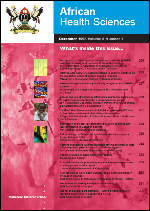
|
African Health Sciences
Makerere University Medical School
ISSN: 1680-6905
EISSN: 1680-6905
Vol. 16, No. 1, 2016, pp. 306-310
|
 Bioline Code: hs16041
Bioline Code: hs16041
Full paper language: English
Document type: Research Article
Document available free of charge
|
|
|
African Health Sciences, Vol. 16, No. 1, 2016, pp. 306-310
| en |
Lower limb and associated injuries in frontal-impact road traffic collisions.
Ammori, Mohannad B.; Eid, Hani O. & Abu-Zidan, Fikri M.
Abstract
Objectives: To study the relationship between severity of injury of the lower limb and severity of injury of the head, thoracic, and abdominal regions in frontal-impact road traffic collisions.
Methods: Consecutive hospitalised trauma patients who were involved in a frontal road traffic collision were prospectively studied over 18 months. Patients with at least one Abbreviated Injury Scale (AIS) ≥3 or AIS 2 injuries within two AIS body regions were included. Patients were divided into two groups depending on the severity of injury to the head, chest or abdomen. Low severity group had an AIS < 2 and high severity group had an AIS ≥ 2. Backward likelihood logistic regression models were used to define significant factors affecting the severity of head, chest or abdominal injuries.
Results: Eighty-five patients were studied. The backward likelihood logistic regression model defining independent factors affecting severity of head injuries was highly significant (p=0.01, nagelkerke r square = 0.1) severity of lower limb injuries was the only significant factor (p=0.013) having a negative correlation with head injury (Odds ratio of 0.64 (95% CI: 0.45-0.91).
Conclusion: Occupants who sustain a greater severity of injury to the lower limb in a frontal-impact collision are likely to be spared from a greater severity of head injury.
Keywords
Frontal-impact; lower limb injury; road traffic collision
|
| |
© Copyright 2016 - African Health Sciences
|
|
